Amid intensifying climate impacts, the UN Environment Programme (UNEP) released its Atlas of Environmental Change for Kyrgyzstan on March 26, offering a comprehensive assessment of the country’s growing environmental risks and response strategies.
Warming at Twice the Global Rate
According to the Atlas, average annual temperatures in Kyrgyzstan have increased by 1.2°C between 1960 and 2023, double the global average of 0.6°C. This accelerated warming has exacerbated water scarcity and the likelihood of natural disasters, a trend expected to intensify in the coming decades. While water availability declines, demand continues to rise, particularly in agriculture.
The report stresses the urgent need for robust climate adaptation measures, including reducing irrigation losses, upgrading early warning systems, and improving pasture management. Currently, an estimated 70% of Kyrgyzstan’s pastures are degraded.
Declining Water Resources
Hydropower accounts for up to 93% of Kyrgyzstan’s electricity generation. But as the climate shifts, rainfall patterns, snow cover, and glaciers are changing, threatening the water inflows that power these systems. Water flow into the Toktogul Reservoir, which feeds the country’s largest hydroelectric plant, could decrease by as much as 18.8% by 2050.
This poses a serious threat not only to energy security but also to regional cooperation, as Kyrgyzstan lies upstream of many major Central Asian rivers. The report underscores the importance of transboundary water management.
Disasters on the Rise
Natural disasters are also becoming more frequent and severe. On average, Kyrgyzstan experiences around 200 emergencies per year, 90% of which are linked to natural hazards such as floods, earthquakes, mudslides, rockfalls, and avalanches.
In 2022 alone, nearly 150 lives were lost to natural disasters. Between 2012 and 2018, the average annual economic loss from such events reached $27 million.
Conservation Achievements
Despite the mounting risks, the Atlas also highlights Kyrgyzstan’s environmental progress. Forest cover has increased from 6.2% in 2000 to 6.9% in 2023, a significant feat given the country’s mountainous terrain. Protected areas have expanded from 0.5 million hectares in 2000 to 1.5 million hectares, with plans to increase this to 10% of national territory by 2040, safeguarding up to 65% of species listed on the IUCN Red List.
All forests in Kyrgyzstan are protected from commercial logging. Notably, the creation of the Khan Teniri Nature Park has expanded snow leopard habitat in the Central Tien Shan mountains by 40%.
A Tool for Climate Policy
The UNEP Atlas offers Kyrgyz policymakers a vital evidence base for sustainable environmental management and climate adaptation. It is designed to guide future strategies as the country faces mounting ecological and socio-economic pressures.









